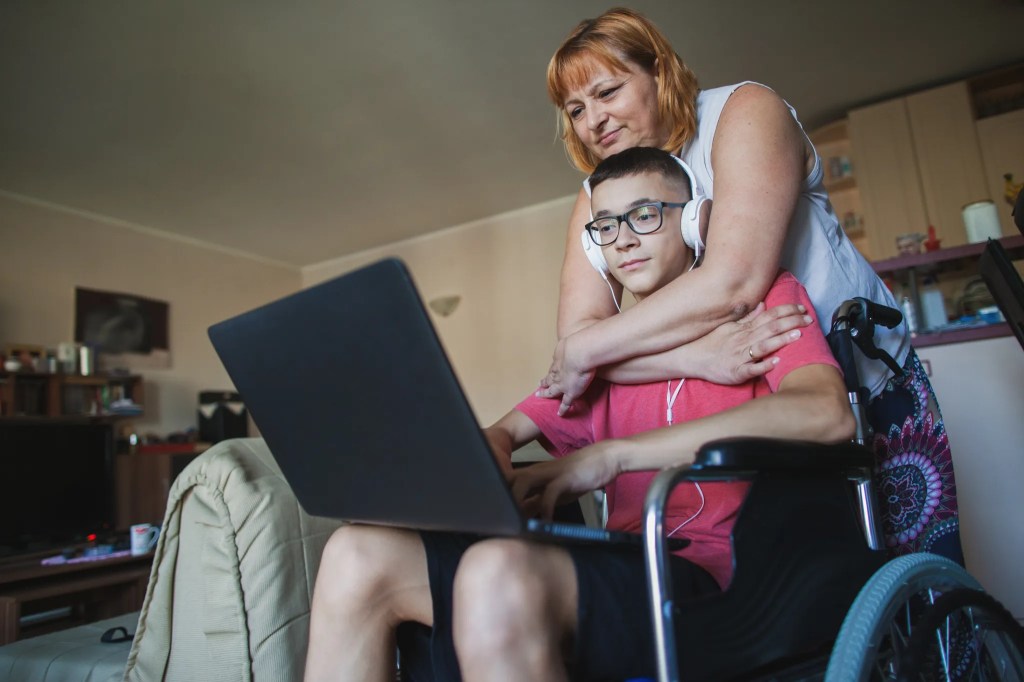
What is Telehealth Nursing? Examples & Benefits in a Post Coronavirus World
The COVID-19 pandemic has left the world in a state of crisis for most people, but for people with compromised immune systems, such as those with disabilities and older adults, the risks are even more concerning. Likewise, family caregivers who provide care for their loved ones must be especially cautious venturing outside the home, as exposing themselves to a dangerous virus like the coronavirus means exposing their care recipients, too. Telehealth nursing is a vital service during this period of crisis, and in this post, we’ll discuss the definition of telehealth nursing, examples, and how it’s benefiting seniors, disabled persons, and family caregivers during the coronavirus pandemic and beyond.
Definition of Telehealth Nursing
Telehealth nursing is the use of telecommunications and other electronic and digital technologies to conduct nursing and deliver care remotely. Telehealth nursing is a component of telemedicine and is also known as telenursing and nursing telepractice. It can be conducted anywhere the necessary technology is in place, such as prisons, private homes, doctor’s offices, clinics, and hospitals.
As the world is coping with the coronavirus pandemic, telehealth nursing enables older adults, people with disabilities, and family caregivers to receive essential nursing services and clinical advice without the need to visit a healthcare provider’s office for a face-to-face visit. By enabling these vulnerable populations to receive nursing services without leaving their homes, telehealth nursing makes it possible to avoid unnecessary exposure to the coronavirus and other potential illnesses.
What are Examples of Telehealth Nursing?
Nurses have been using the telephone for decades to discuss healthcare concerns with patients, such as communicating the results of lab testing, discussing medication refills, and providing advice for how to manage symptoms or minor health conditions at home. Today, telehealth nursing encompasses far more than just telephone communication, including a variety of technologies such as patient portals, videoconferencing, Remote Patient Monitoring (RPM), and other tools.
Telehealth nursing also can be used in emergency situations, allowing nurses from around the world to perform triage over the telephone, a prominent benefit during crises like COVID-19. Nurses can provide instructions for dressing minor wounds or treating minor burns at home, as well as leverage mobile health devices to take blood pressure readings, monitor oxygen levels, check blood sugar levels, monitor heart rate and respiration, and other health statistics. Telehealth nursing also is increasingly used for pre- and post-surgical care.
Telehealth nursing has become an extension of many healthcare providers’ offices, as well as some hospitals and health plans. For example, some health insurers offer telehealth nursing services as part of workplace wellness programs, with regular check-ins with employees to discuss their general health status, the management of chronic health conditions, and wellness advice. In the wake of the coronavirus pandemic, it’s likely that telehealth nursing will become even more prevalent in response to the growing awareness of the potential for the community spread of disease.
What Technologies are Used for Telehealth Nursing?
There are several technologies commonly used in telehealth nursing:
- Live Video Conferencing: Live video conferencing technologies enable telehealth nurses to connect with patients and their caregivers in real-time. The experience is closer to that of face-to-face interaction compared to telephone conversations, which is comforting to many patients and caregivers.
- Remote Patient Monitoring: Remote Patient Monitoring technologies use wearable technology, medical devices, and health applications to collect patient health data and transmit that information to telehealth nurses and other providers. RPM technologies enable telehealth nurses to detect changes in a patients’ health status or signs of non-compliance and connect with patients to recommend changes before serious health complications occur. For family caregivers, knowing that a qualified nursing provider is keeping an eye on their loved one’s health statistics provides peace of mind.
- Store-and-Forward: Store-and-Forward technologies rely on secure servers and routers to capture, store, and transmit images, documents, and other important patient data. For example, a photo of a patient’s rash can be captured and sent to a healthcare provider for assessment and diagnosis, or images such as X-rays can be sent between departments for consultations. This technology saves caregivers from having to travel to multiple providers’ offices for secondary consultations in many situations.
Benefits of Telehealth Nursing During the Coronavirus Pandemic & Beyond
Telehealth nursing is a practical method for delivering nursing care in a variety of situations, from providing routine follow-up advice after a procedure or office visit to offering advice for managing symptoms associated with a chronic health condition. Remote Patient Monitoring, for instance, is one technology used in telehealth nursing that supports better management of chronic health conditions, such as diabetes and COPD, by reducing the need for in-person office visits. Reducing unnecessary exposure to other people who could possibly be sick is especially important for people with compromised immune systems, such as seniors and people with disabilities, as well as those who care for them.
With more frequent communications between patients and telehealth nurses, less time between contacts is particularly helpful when patients have lapsed in their responsibilities. For instance, if a diabetic patient has not been regularly checking their blood glucose levels, telehealth nurses are aware of missed readings thanks to RPM technologies and can reach out to help the patient get back on course. In traditional delivery models, weeks to months may pass before the patient’s healthcare provider becomes aware of the lack of regular monitoring, putting the patient at increased risk of dangerous complications.
Telehealth nursing also is beneficial for patients who reside in rural areas who typically have less access to healthcare compared to those who live in more populated areas with a larger number of healthcare providers. While rural patients may have to travel for an hour or more to access in-person healthcare services, telehealth nursing is accessible from their living rooms.
During the coronavirus pandemic, telehealth nursing has become a vital component of the healthcare delivery system, making it possible for seniors and people with disabilities to avoid exposure by receiving nursing services remotely. As family caregivers often spend a significant amount of time with their care recipients, being exposed in the community introduces the risk of second-hand exposure to their care recipients. Because they don’t have to venture out into the community or visit a provider’s office to discuss their care recipient’s care with a nursing provider, family caregivers can avoid being exposed to COVID-19 and other illnesses, as well – ultimately keeping those they care for safer.
How Does Telehealth Nursing Impact Caregiving?
Telehealth nursing makes nursing care more accessible, which is a tremendous benefit for elderly and disabled patients and their caregivers. For patients with mobility challenges, telehealth nursing is far easier to access and doesn’t require traveling to a provider’s physical office location. The same is true for patients and caregivers who lack access to convenient transportation options.
The availability of telehealth nursing offers an added sense of security for caregivers, as well, giving primary caregivers more confidence that they can meet their loved one’s needs. Access to telehealth nursing services can help to reduce caregiver stress and fatigue, thanks to the knowledge that they can reach out and connect with a qualified telehealth nursing professional for advice anytime it’s needed.
Telehealth nursing makes it easier for caregivers to communicate information about their loved one’s symptoms and overall health status with their care team through patient portals and other tools, as well. With the ability to easily communicate changes as they arise, caregivers and telehealth nurses are valuable partners who play increasingly important roles in the care team. While the importance of this partnership may be becoming increasingly clear during the coronavirus crisis, telehealth nursing will become increasingly prominent as the world moves beyond the current pandemic.
More insights like this:
-

Challenges Caregivers Face in Personal Relationships
Read more: Challenges Caregivers Face in Personal RelationshipsEveryone has different expectations for the challenges that a caregiving role might bring, such as the difficulty of managing a loved one’s medical needs or transporting them to appointments. But there are social impacts for caregivers as well. Caregiving goes beyond helping a loved one with health and wellness at home; it can…
-

Caring For Your Child With Disabilities
Read more: Caring For Your Child With DisabilitiesAccording to AARP’s Caregiving in the U.S. 2020 Report, 14.1 million caregivers provide care for children ages 0-17. In addition, one-in-ten parents in the U.S. provide over two and a half hours of unpaid care a day to an adult child. That’s a lot of care. A lot of dedication. And a lot…
